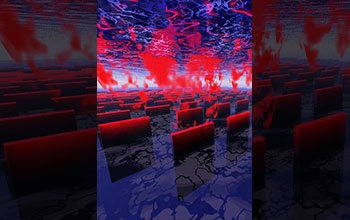Multimedia Gallery
A strategy for building self-regulating nanomaterials
A strategy for building self-regulating nanomaterials relies on an array of tiny nanofibers, akin to little hairs, embedded in a layer of hydrogel.
More about this image
In 2012, a Harvard University-led team of engineers presented a strategy for building self-thermoregulating nanomaterials that can, in principle, be tailored to maintain a set pH, pressure, or just about any other desired parameter by meeting the environmental changes with a compensatory chemical feedback response.
Called SMARTS (Self-regulated Mechano-chemical Adaptively Reconfigurable Tunable System), this newly developed materials platform offers a customizable way to autonomously turn chemical reactions on and off and reproduce the type of dynamic self-powered feedback loops found in biological systems.
The advance represents a step toward more intelligent and efficient medical implants and even dynamic buildings that could respond to the weather for increased energy efficiency.
The research was supported in part by the National Science Foundation (grant CMMI 1124839).
Read more in the Harvard University news story Smart materials get SMARTer. (Date image taken: July 2012; date originally posted to NSF Multimedia Gallery: Dec. 27, 2017)
Credit: Simulation image courtesy of Ximin He and Lauren Zarzar, Harvard University
Images and other media in the National Science Foundation Multimedia Gallery are available for use in print and electronic material by NSF employees, members of the media, university staff, teachers and the general public. All media in the gallery are intended for personal, educational and nonprofit/non-commercial use only.
Images credited to the National Science Foundation, a federal agency, are in the public domain. The images were created by employees of the United States Government as part of their official duties or prepared by contractors as "works for hire" for NSF. You may freely use NSF-credited images and, at your discretion, credit NSF with a "Courtesy: National Science Foundation" notation.
Additional information about general usage can be found in Conditions.
Also Available:
Download the high-resolution JPG version of the image. (343.2 KB)
Use your mouse to right-click (Mac users may need to Ctrl-click) the link above and choose the option that will save the file or target to your computer.

 All images in this series
All images in this series